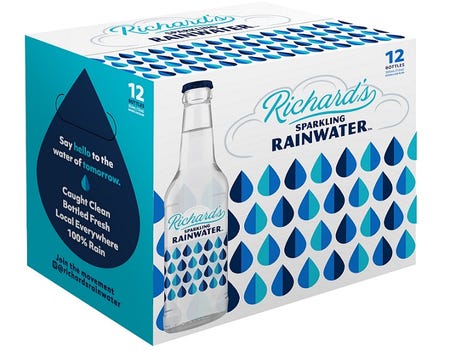Richard’s Rainwater, claimed as the most sustainable bottled water company on earth, eliminates plastic bottles in favor of glass and aluminum packaging.
June 24, 2020

The sky’s the limit for Austin, TX-based Richard's Rainwater, a 100% sustainable, naturally captured, pure rainwater that’s captured before it hits the ground. The water is free of any natural or manmade contaminants — the company says the rainwater is 100x cleaner than the strictest bottled water standards even before being ultra-filter purified.
Unlike single-source waters, rainwater can be collected almost anywhere, making it the most sustainable water the planet provides. Dedicated to minimizing its carbon footprint, Richard's Rainwater builds local, low-energy rainwater capture centers as close to customers as possible.
Since 2002, the brand has promised to be most sustainable bottled water company on earth.
“Rainwater is unquestionably the most sustainable source of drinking water on the planet,” explains company president and CEO Taylor O’Neil. “We’re committed to continuously improving on everything when it comes to sustainability, and that means bringing our packaging up to meet the high standards of our water. Based on what Bea Perez said at Davos, Coca Cola doesn’t seem to agree that this is an urgent issue. But we have confidence that our consumers want a better future for the planet and we’re thrilled with the response from our partners.”
The company announced packaging changes to “more environmentally-friendly packaging” this spring. O’Neil responds to Packaging Digest’s questions about the packaging changes and the company.

How did the idea to harvest rainwater originate?
O’Neil: Founder Richard Heinichen moved with his wife to hill country, Texas, where he soon became frustrated with drinking water options. After some independent research, he determined that his whole house could run on rainwater. Richard installed his first rainwater system in 1994. His neighbors noticed the difference every time they visited. Richard initially launched a business installing home rain harvesting systems all over Texas. Always curious and never wanting to be without rainwater, he decided he must learn how to bottle rain on a job in the heat of the Texas Summer. It took him four years of certifications, back and forth with regulators and lots of hard work but he became the first person to get approval to bottle rainwater in the US in 2002 and he's been doing it ever since.
What's been the market response?
O’Neil: We're fortunate to live in a place where the incredible global clean water issues are less prevalent than in other parts of the world. In many cases, consumers we talk to haven't thought much about where the water they drink was sourced, how it was purified or how far it has traveled to get to their hands. When we tell our story and communicate why rainwater matters beyond the bottle or can they are drinking, we find most people say "I'm never going to drink another kind of water again."
The bottled water industry is notorious for a lack of actual product innovation and destructive environmental practices. Most "brands" are just that - fancy marketing gimmicks that distract from the reality of the water inside the packaging. Consumers love finding there is a product they can drink and feel good about the decision they made - Richard's Rainwater.
Tell us about the recent packaging changes.
O’Neil: We updated the packaging aesthetic in March of 2018. The redesign was intended to communicate that the water inside the package is real rain, caught clean before it hits the ground, and to articulate why rainwater capture is better for you and better for the planet.
At the end of 2019, we made the decision to move our still-water SKUs away from single-use plastic bottles in favor of more environmentally friendly cans and glass bottles. 
We know rainwater is the most sustainable source of clean water. Our team is continuously evaluating all of our decisions to ensure every aspect of our business matches the quality and commitment as our source water. The cans and large format glass bottles hit the market this summer and have met with incredible prelaunch enthusiasm.
Where are the products available and what's the suggested pricing?
O’Neil: We are available in retailers like Whole Foods, HEB, The Fresh Market and lots of regional natural channel locations. We have three products, still rainwater in 16-oz aluminum cans (~$1.49), still rainwater in 750-mL glass bottles ($2.99) and sparkling rainwater in 12-oz glass bottles ($1.49). We're also excited to be announcing several new “wins” over the coming months!
Where are the rain collection (bottling) locations?
O’Neil: Rain is still captured at the original site in Tank Town in Dripping Springs, TX, which is in process on converting from a bottling site to a hospitality venue. Also, our new partners at Lazy Magnolia Brewery now bottle rain in Kiln, MS.
We just announced adding the Houston area in partnership with Buffalo Bayou Brewing where construction for the operations will be starting in a couple of weeks.
In addition, we’re in the regulatory process for a project in Atlanta and evaluating options in the Northeast and Pacific Northwest.
Ed. Note: The brand collects more than 30,000 gallons of water when there's an inch of rain at one of the company’s collection sites.
You May Also Like


